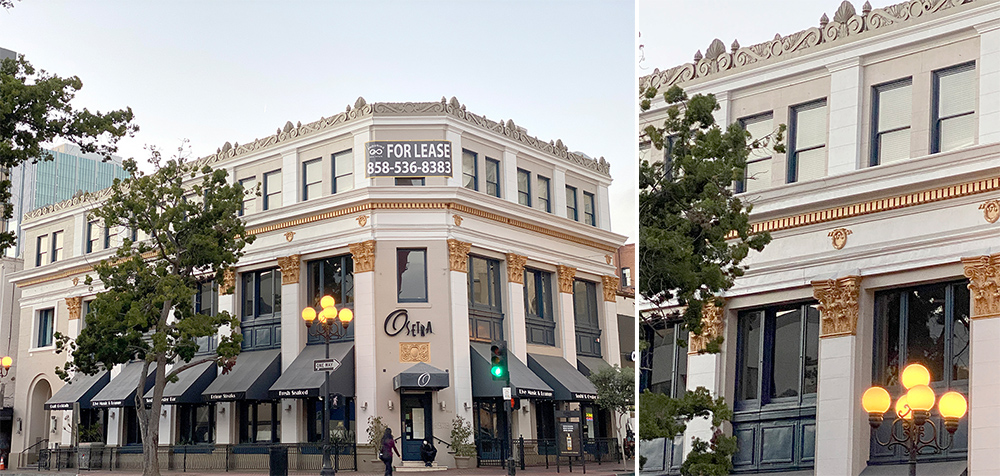
SANDEE WILHOIT
Gaslamp Quarter Historical District
The stately Victorian building still standing on the corner of 5th and E has housed many financial institutions and numerous businesses. Having undergone several remodels, it is a testament to imagination, transformation and progress.
It was originally sold by Alonzo Horton to James Kearney, a grocery man, on February 9, 1869. By January of 1874, Kearney had transferred the property to Joseph Campbell, who sold it with a profit to the Thomas Brothers, Richard and John. The brothers joined forces with Jacob Gruendike, a local successful businessman. The newly formed threesome set about to plan their new endeavor — the establishment of a national bank in the growing city of San Diego.
Gruendike, who was president of the San Diego Water Company, the Coronado Peninsular Railroad and the San Diego Lumber Company, was to serve as president of the new bank, while Richard Thomas would be the vice-president and his brother would be the cashier. They were very eager to begin operations, which necessitated them initially opening the new “Bank of Southern California” in the De Level Building on the corner of 5th and F.
The partnership quickly moved the frame structure on their property, and had plans for a brick structure drawn up by A. W. Delane. The first story and the full brick basement of the edifice was to be constructed immediately, with two additional stories to be added in the next year. On September 12, 1883 work began on the structure and the building was com-pleted on February 5, 1884.The San Diego Union described it as “elegant with the finish-ing work as by far the finest in the city.” The exterior walls were masonry over brick, while the interior walls were painted plaster with marble wainscoting in the halls and wood pan-eling. The banking room, which was 50-by-75 feet was entered through double doors from 5th St., and featured a horseshoe shaped lobby surrounded by mahogany counters with railings of burnished brass and heavily beveled French plate glass. The floor was Italian marble, and the ceilings were 16 feet high. To the right of the entry was a 10-by-10-foot room, the office of the vice president. The office of the president was towards the rear of the main floor.
In the basement level, directly across from the Director’s Rooms, was the vault. It was a 9-by-12-foot brick room with six feet of stone and cement underneath as a foundation. The walls were two foot thick and heavily lined with iron. Thus, it was both burglar proof and fireproof. The safe was a Beard Brothers screw door safe with a time lock attachment. To this day, the vaults and safety deposit boxes are still in the basement, still intact, and it is said that some of the boxes are still sealed. All the basement rooms were also heavily car-peted.
Assets were transferred from the De Level Building, and the bank opened as the First Na-tional Bank of San Diego. As one might suspect, such an opulent setting drew many of the city’s most formidable men who desired to operate their businesses from the building. To accommodate their growing clientele, the partnership began construction on the second phase of their project, adding two more stories, four more vaults and an elaborate folding security gate across the front door. The renovations, which cost $15,000, were completed in 1886.
In 1885, two gentlemen, Hampton Story and Elisha Babcock, made a notable deposit of $50,000 in the bank. Gruendike promptly installed them on the Board of Directors. A very smart move on his part, as Babcock and Story formed the Coronado Beach Company and built the Hotel Del Coronado! They kept their offices in the bank building, as did other well known San Diegans— John D. Spreckels, George Puterbough, a Superior Court judge, ar-chitects W.S. Hubbard and the Reid Brothers (Hotel Del Coronado), Ephraim Morse and several attorneys and judges.
Another more infamous tenant was the International Company of Mexico, which was formed in 1887 for the purpose of “inducing immigration to Lower California” near Ense-nada. Although their business practices were somewhat suspect, the Mexican consul, who was also a tenant in the bank building, said he had “no objections” to their methods and practices.
In 1922, the Security Commercial and Savings Bank, forerunner of the Security Trust and Savings Bank, purchased the building and began a complete overhaul of the aging struc-ture. Although it was simplified and much of the ornate trimming was pared down, the building survived intact. With its new look, it continued to draw prominent professionals to its doors and offices.
In more modern times, it was purchased in 1973 by Gaslamp pioneer, Tom Hom and his brother Dr. George Hom. The Hom brothers opened the Far East Trading Company, special-izing in Asian products on the first floor. The San Diego Republican headquarters leased the second floor.
In 2004, Osetra, an upscale restaurant, opened at the location. The high ceilings provided an area for “wine angels” to ascend to the wine tower on a wire, select a wine, and then slowly descend to the appropriate floor to deliver the wine. Due to COVID, the restaurant is now only open for takeout.
Throughout all its incarnations, the First National Bank Building has endured as a symbol of the zeal, enthusiasm and ingenuity that has made the Gaslamp Quarter and San Diego an international tourist destination and America’s finest city.
— Sandee Wilhoit is the historian and lead tour guide at the Gaslamp Quarter Historical Foundation. She can be reached at [email protected].








